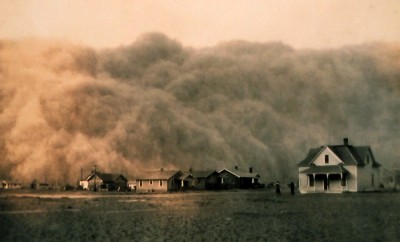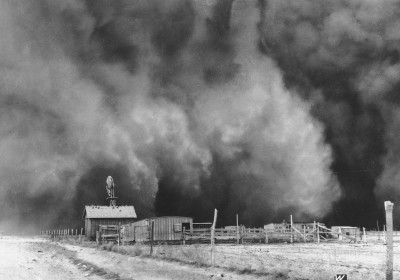
Image source: wikipedia
The past few years have been hopelessly dry when it comes to precipitation, especially for our fellow off-the-gridders in the West, Southwest and Plains regions of the U.S. In fact, climate scientists are even calling this particular rainless period a “megadrought,” adding that we could be looking at the worst dry spell in 1,000 years.
That’s some pretty big talk, especially when it comes from folks at National Geographic. But this now begs the question – if such a drought only happens once in a millennium, then what are the residual effects going to be? Well, some are suspecting that we might soon be looking at a Great Depression-era climate throwback: the next Dust Bowl.
Let’s have a look at the facts.
The Makings of a Dust Bowl
When the Dust Bowl swept through the prairies of the U.S. and Canada in the 1930s, it destroyed farmland and much of the environment. Farmers, hoping to grow more crops, had stripped the land of soil-holding grass and trees. When a long drought hit – and heavy winds kicked up – all the dry, loose dirt formed blinding, lung-choking dust storms that travelled across the Plains to cities such as New York. Over the course of four years, dust storms were common and more than 60 percent of the people in the affected areas – about 2.5 million – abandoned their farms and homes to move elsewhere, according to the “The Reader’s Companion to American History,” edited by Eric Foner and John A. Garraty.
Now, some say it could very likely happen again. In fact, the current drought in the West has cost California more than $1 billion in crop losses, according to the Los Angeles Times.
New Survival Seed Bank™ Lets You Plant A Full Acre Crisis Garden!
John Laird, state secretary for natural resources in California, told the Times that the agricultural industry has faced an economic loss of $1.5 billion while fallowing 400,000 acres and laying off 17,000 farm workers.
“In a certain sense, we’re in a dust bowl,” Greg Okin, a University of California, Los Angeles geographer, told Smithsonian Magazine at the beginning of the current drought. “If the next three years or five years [are] a drought, even if it’s not that bad, if we start seeing continual dust storms, then that would be really no different from what was the Dust Bowl.”
So, What Does the Sun Have to Say About It?
 Could sun activity play a role? We’ve long known that if you want to get an idea on just how much electromagnetic energy that the sun is radiating, then sunspots are a strong baseline indicator to ascertain this information.
Could sun activity play a role? We’ve long known that if you want to get an idea on just how much electromagnetic energy that the sun is radiating, then sunspots are a strong baseline indicator to ascertain this information.
However, the interesting part is that the sun has cycles within cycles within cycles, and solar electromagnetic activity is no exception. There are solar maximums and solar minimums, and we’ve come to learn that each phase has its own unique effect on the earth.
Trust Your Gut On This One
In a previous article, I’d mentioned that solar “minimums” (less sunspots) have a dramatic cooling effect on the planet, even linking well-known minimums with little ice ages. Well, wouldn’t you know it, there really does seem to be a correlation to note. Here are periods that experienced higher-than-average sunspot counts (not necessarily in relation to the 11-year solar cycle), according to research conducted by Timo Niroma…
- 1910-1936
- 1940-1966
- 1960-1986
Come to think of it, right around the end of each high period, it looks like we’ve got some iconic and extremely bad drought period in American history. For instance…
- 1930s Dust Bowl
- 1950s Drought
- 1980s Drought
And as fate would have it, the current solar cycle, known as solar cycle 24, reached its peak in 2013, with the current “megadrought” that began in 2012.
Look at the Tree Rings
Tree-ring records from the American Southwest suggest that a drought caused the residents of Mesa Verde, Colorado, to move.
Discover The World’s Healthiest Storable Survival Food!
“The historical record shows us a community that may have failed environmentally,” David Stahle, a tree-ring scholar from the University of Arkansas, told the science website AAAS.org. “We are doing the same thing now in terms of our heavy consumption of water and fossil fuels.”
Well, you might also find it interesting that there just so happened to have been “a major maximum of sunspot activity spanning the 12th and 13th centuries,” according to research by John E. Beckman, and Terence J. Mahoney.
Which brings us back to today.
If the cause of drought conditions happen to be the result of heavy solar activity, then 2015 could be another bad year.
Richard Seager, a climatologist at the Lamont-Doherty Earth Observatory of Columbia University, told National Geographic that much of the country will be impacted. It just so happens that those states are the ones that feed America.
“We expect that the southern part of the United States and south Plains get drier over the current century,” Seager said, “so in places like Texas, New Mexico, Arizona, yes, you would expect events like this to become more likely.”
Do you believe another dust bowl is possible? Share your thoughts in the section below:
During A Disaster, Which Items Will Be The First To Disappear From Stores? Read More Here.
 Off The Grid News Better Ideas For Off The Grid Living
Off The Grid News Better Ideas For Off The Grid Living



